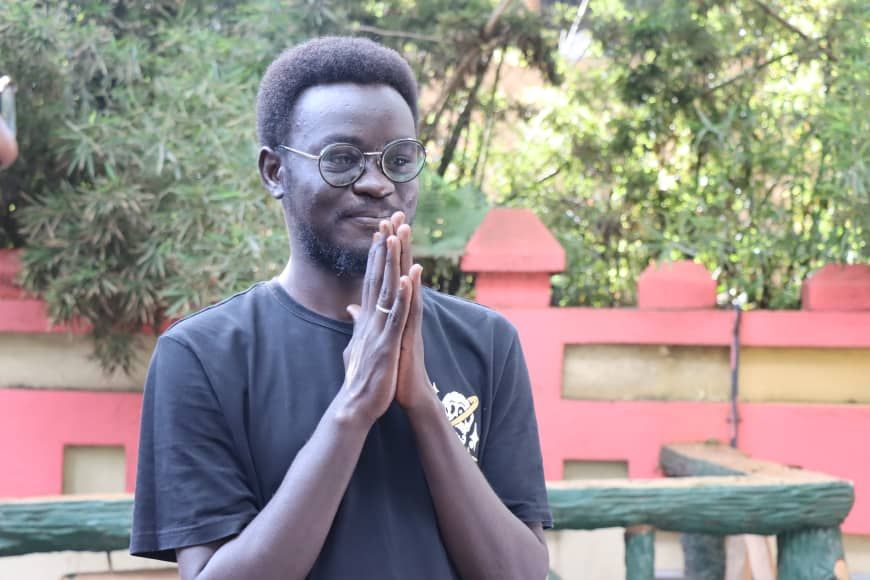Trigger Warning and Disclaimer: the content that you are about to read contains graphic and sensitive experiences. Reader discretion is advised. Read our full editorial notice here.
Notice: This article was written before the outbreak of the April 15th war, and it is an article in the context before April 15th.
Do not shed tears, my beloved,
"Tomorrow, we shall undoubtedly return to our homeland."
With the rising sun on the seventeenth of June 2019, two weeks after the massacre that dispersed the protesters in front of the General Command of the Army in Khartoum, and its garrisons in the states, Sudanese men and women had to bid farewell, one last time, to a singer who had symbolized a revolutionary guide for many of them.
Perhaps she won't shed tears again, but throughout her artistic journey that spanned almost thirty-eight years, she did nothing but what committed artists do: weeping nobly on behalf of the people and shedding tears in an innovative form. She left a musical legacy for her people that lasted four decades in their modern history.
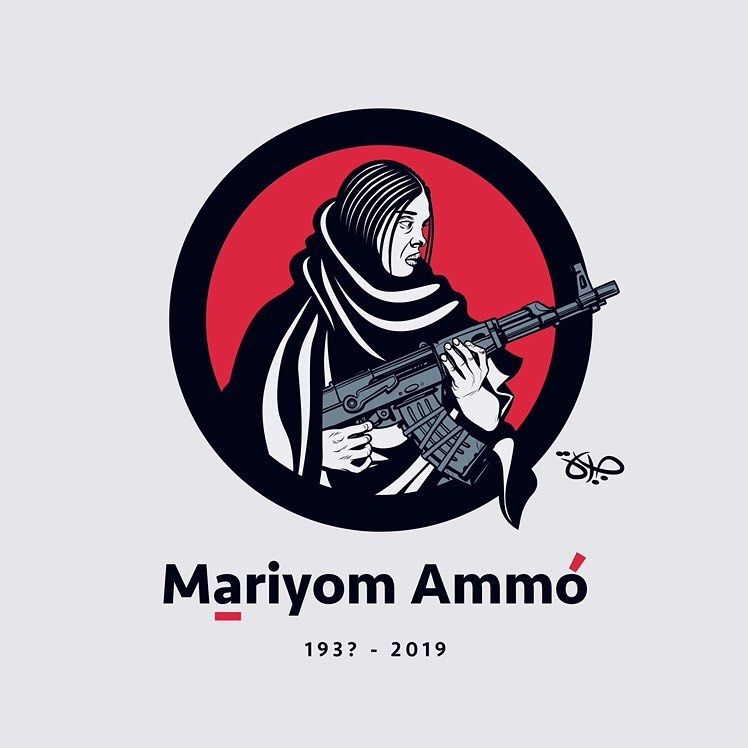
Maryam Amo. Via Iquna boutique on Facebook
(Do)
Ammou left at a time when the political, social, and economic conditions in the country had reached a critical point. The state's violence expanded geographically to encompass new areas, while the region of Darfur, in general, and the Fur community, in particular, experienced a profound political divide that struck the Sudan Liberation Movement and Army, and contributed to a political division within the Fur community. The Inqaz regime worked to weaken the native administration by assimilating them and severing their relationship with the issues of their communities. Ammou departed amidst a revolution in which she was at the forefront, among Sudanese women who unleashed ululations and songs in its squares and various moments. She was confident, asserting, "We know how to deal with Bashir,” a statement that echoed with the assured and defiant tone of the renowned Bahri neighborhoods committees.
The start of the new millennium marked a turning point in Ammou's life. She found herself caught up in a powerful social revolution gaining momentum in the country's history. This shift would dramatically shape both her personal and professional life. In her artistic work, she became a significant voice for the movement, contributing to its discourse. Her personal life, meanwhile, mirrored the ups and downs of this social upheaval.
(Re)
As an artist, Ammou - alongside Kyoka, Bonga, and Ismail Arbab - undertook the task of outlining the general features of what the song sung in the Fur language might be in the future. Naturally, engaging in the realm of a particular art implicates the artist in other fields due to the intersecting nature of human life and art. This burden is compounded in societies that have not yet firmly established traditions in these fields. Ammou needed to expand her artistic work. To do that, she explored related areas like language, rhythms, and themes found in Fur music. This journey promised a significant change in the culture tied to the Fur language and its speakers.
Naturally, engaging in the realm of a particular art implicates the artist in other fields due to the intersecting nature of human life and art. This burden is compounded in societies that have not yet firmly established traditions in these fields. Ammou needed to expand her artistic work. To do that, she explored related areas like language, rhythms, and themes found in Fur music. This journey promised a significant change in the culture tied to the Fur language and its speakers.

Sudan map showing the location of Darfur Region: Source DOI: 10.1007/s11259-021-09815-1
As a result of her engagement in the untapped cultural heritage of the Fur society, she became intimately linked with subtle social transformations. She possessed the ability to observe problems in a more critical way compared to others. She mingled, leveraging her symbolic wealth with the elite, the affluent, and the small bourgeoisie among the sons and daughters of the Fur. Yet, she refused to let it become a societal barrier, hindering her from criticizing the social and economic issues of her community. Through various songs, like "Neighbors' Unity," she endeavored to expose the class dynamics in her society in her distinctive way.
O keepers of plentiful cattle,
Behold, you have seated yourselves beneath the shades
And you fell in love with your wealth
O keepers of plentiful cattle,
Beneath the shadows, you all sat
The destitute, scorched under the relentless sun
As he gathered the scattered remnants of wealth
Let the destitute weave bonds with his kin
We do not reject him
In the rhythmic beats of the Franqabiya, Ammou sang her song—a melody widely embraced in the festivities of unions . Yet, it seemed as though she transformed the marriage celebration into a platform for exposing societal divides. Here, a subtle nod to the hurdles confronting cross-family marriages due to the barriers of class, a social quandary vividly manifesting in the rural tapestry. However, she did not overlook the social role of wealth when employed judiciously, as eloquently depicted in the song "Peoples of the Lands'':
We, the people of the lands, are strangers to one another
Wealth is the alchemy of our thick trail of blood
Intermarriage is what blended our bloodlines
Circumstances are what intertwine our blood
What Ammou was attempting to do in the face of the reality of social disparity was to maximize the collective benefit of wealth through intermarriage, seeking to avoid the problem of the class barrier that hinders the understanding between people. Perhaps her primary concern was with the institution of family and marriage, but this made her capable of highlighting the issue of social and class distinction that surfaces during any marriage process. Thus, the marriage process transformed into a starting point from which to criticize the social conditions of her society.
Ammou addressed class distinction, labor, migration, and numerous issues and problems related to poverty in complete songs or within songs that tackled other subjects. The song "Here Comes the Heir of the Rich" can be described as the harshest portrayal of social disparity and the gap between the rich and the poor.
Behold, the rich man's son approaches
The horns of his cows drip with milk
The mother of the poor finds milk only in the care of others
In exploring the subjects she attempted to tackle, Ammou played the part of an informed individual shaped by societal conflicts, gaining popular awareness—meaning she did not adhere to any specific theory. In her own way, she also came to believe that social change is achievable and got involved in different efforts to bring about change on various levels.
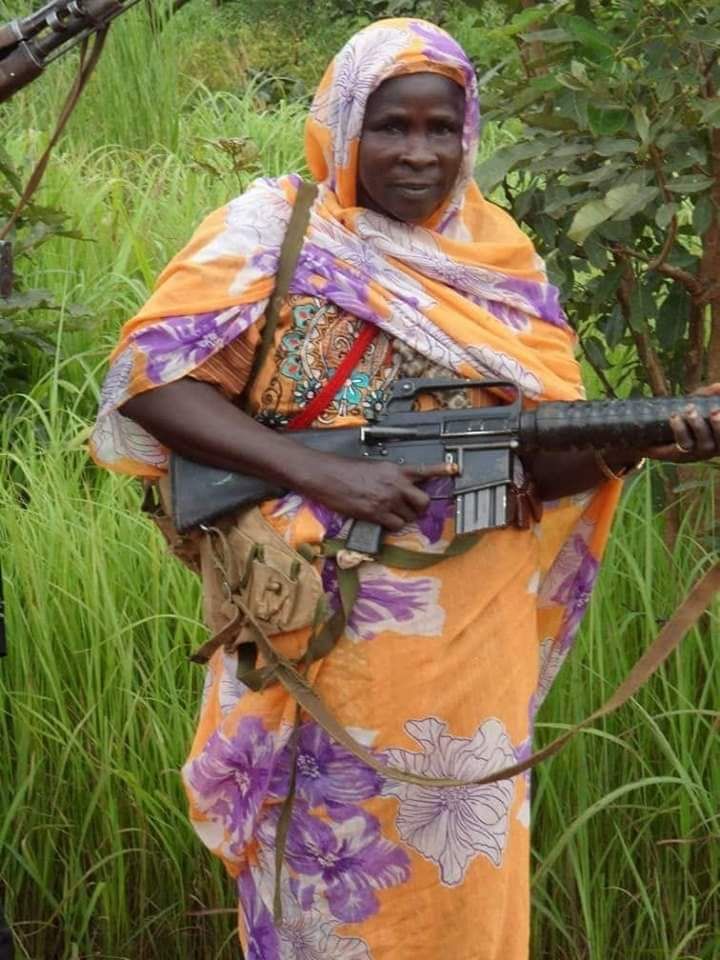
Maryam Ammou. Source Mustafa Abdelgadir
(Mi)
Ammou marked a presence in the centers dedicated to the development of the Fur language and institutes teaching its books. Anyway, who could be happier to write a language than its poets and singers?
Imagine the concern that may have crossed her mind with the decline in the number of Fur language speakers, a language that represents her cultural domain, the realm of images, ideas, and myths that constitute the substance of her art. Was the artist's fear of forgetting, a reason for urging her family to make the mother tongue the primary language of communication?
Through the interview conducted by journalist Abdul-Monim Maki for Radio Afiya Darfur, it becomes evident that she was aware that the marginalization afflicting the Darfur region had harmed the art of singing. Since language was her primary tool, undoubtedly, she was the first to sense the looming danger to the Fur language due to structural and organized marginalization.
Naturally, it is not required for an artist to articulate a separate theory about the world from their artistic work. However, any artistic creation ultimately involves themes or ideas that make the artistic creation possible. These may be the result of the artist's personal experience or part of the cultural context within which art is produced. Uncovering these ideas and themes remains the task of critics, without neglecting the context within which the artist operates to avoid arbitrary judgments.
(Fa)
On 25 April 2002, at six in the morning, a joint force from two armed movements stormed El-Fasher Airport. They destroyed several aircraft and inflicted significant losses on the army. These movements would later be known as the Sudan Liberation Movement/Army and the Justice and Equality Movement. The movements constituted a revolutionary initiative with demands related to the fair distribution of power and wealth in the country, aiming to halt the marginalization of the region. It will not take long for the authorities in Khartoum and the state apparatus to ignite a comprehensive war in the region.
Inclining towards the movement was not a choice for Ammou; the war had thrust her society and audience into an awkward existential position. Therefore, if her voice was destined to be heard, let it emerge from within the masses. If her art was to be eternal, let its subject be her people and their trials, ''living beneath the trees and among the rocks'' on the edge of oblivion.
Ammou became an integral part of the movement and the Sudan Liberation Army, leading the forefront of topics that garnered attention. Central to her dialogue, she emphasizes the internal cohesion of the social movement, its unity, and the reconstruction of a society torn apart by war. In her discourse, she stated, 'Unity is the imperative need for the people of Darfur'. The concept of unity permeates throughout Ammou's projects, implicitly or explicitly, even before the outbreak of the revolution. This is evident in works such as 'Let's Gather like the Palm of Unity' and 'Sons of Darfur,' as well as the song "We Want the Rights of Darfur."
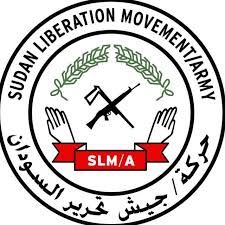
Sudan Liberation Movement/Army logo
Ammou devoted her life to pursuing the dream that could heal the people of this land, capturing it in several songs such as 'Darfur, Charmed My Heart' and 'Abuja.' She documented various occasions and events related to the social movement and revolution, starting with the famine in Darfur in 1984 and the aid provided by the United States to Sudan in the song 'Do not let hunger kill our people.' Her journey extended to criticizing politics and politicians in the final years of her life. She immortalized the martyrs of the revolutionary movement in elegies like 'Tarada,' in addition to celebrating the triumphs of the movement and the revolution.
(Sol)
"In this phase of her project, the word 'land' and its semantic field unequivocally dominate the lyrics of her songs. It seems she positioned the land as a starting point to interpret the revolution, its goals, and the social movement as a whole. Drawing from the vocabulary of the Fur language and its oral tradition, she invoked everything related to the land, resembling what she did with marriage and kinship to present and analyze the social and economic reality of her community. Through her poetry, she reached a high level of symbolic condensation, transforming the land at times into a woman, a mother, and a mother-in-law, as seen in the song 'Let's Go to the Homeland Courageously. "
The cold has scorched our cotton fields.
Our mother-in-law in a single piece of fabric, who will clothe her?
(La)
One night in 2006, Ammou was smuggled from Soba in the east of Khartoum, passing through Kenana, Al-Fao, and Gedarif, until reaching Eritrea. There, she joined the Moral Guidance Brigade of the Sudan Liberation Movement/Army under the leadership of Abdulwahid Al-Nur. This happened after the signatories of the Abuja Agreement arrived at the palace. After a while, security forces raided her house in the stillness of the night, likely in response to the attacks she had begun launching on the agreement in her songs.
To embark on her intricate relationship with the land and homeland, she will have to sing to the land all day and night without cease in the days to come. From that moment on, she will nurture in her songs the concepts of return to the land, yearning, and estrangement.
I have received news from my homeland
I am going
Will I be able to reach it on foot?
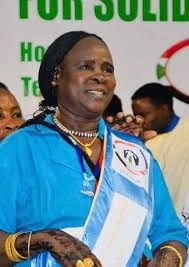
Maryam Amo. Source: Sudanese Journalists Network on Facebook
At this juncture in the history of the movement, her political influence surged, and she played significant roles in shaping collective consciousness, mobilization, and advocacy. It traversed through Eritrea, Uganda, Egypt, South Sudan, Ethiopia, Kenya, and the United States. It built a shared sentiment among its diaspora, advocated for the victims of genocide and ethnic cleansing, and rallied support for the revolutionary cause. The song ''I Am a Student of the People of the Forest" stands out as one of its most impactful and popular revolutionary songs. Every celebration by the Darfur Students Association, the Jebel Marra Students, or any spontaneous gathering or plan for the people of Darfur, especially those who speak the Fur language, is incomplete without this song.
I am a student of the people of the forest
Do not address me as a student in the city
I am a student of the people of the mountain
Do not address me as a student in the city
Many sons and daughters of the Darfur region joined the movement, especially the Fur people who were engaged in marginal trade in the cities during the revolutionary movement when she sang:
You scrub the dishes for the lords of towering buildings
You do not wash your souls
Will you venture into the afterlife while still alive?
In what way does the sale of watermelon seeds avail?
In what way does the washing of cars avail?
In what way does laundering the garments of others bear significance?
Numerous of Ammou’s songs are embodying the noble struggles of her people and their shared destiny, their profound sorrows, and the dreams entwined with the resolution of this challenging period in their history.
(Si)
In contrast, Ammou sparked a revolution within Fur music, revolutionizing the musical composition and infusing lyrics drawn from the colloquial language of everyday activities, all the while exploring new thematic horizons. The princess spread her dominion over the land of Franqabiya, becoming the queen of startled gazelles.
Alongside the father Kyoka and her husband Bonga, they formed the triangle of modern Fur music. She used to perform her songs with a full orchestra before being compelled to reduce the musical instruments in her band after leaving the country. She settled for the piano, saxophone, percussion, and sometimes the flute. During a significant portion of the songs from the diaspora period, she relied on the rebab (a traditional string instrument) and the traditional drum for the Fur and the whistle (a type of flute), perhaps influenced by the revolutionary necessity that influenced the musical style of this period and the instruments used. The whistle, drum, and rebab play a pivotal role in her works, as seen clearly in the song "I Am a Student of the Forest," where the enthusiastic roles of the whistle and drum are evident. In other songs, she solely relied on the rebab.
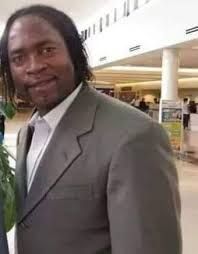
Artist Adam Bonga. Source: Darfur News Network on Facebook
On the linguistic level, Ammou opened up the Fur language to a new political and social discourse that it had not been exposed to before. This language, whose role has diminished for various reasons, including cultural marginalization and the pressure from neighboring languages such as Arabic and English, will be empowered by Ammou with a revolutionary discourse through encoding, borrowing, and metaphors crafted from the language of everyday speech, transforming it into a language of resistance. This is achieved by adding new connotations to many words, such as land, field, students, mother, and forest. Additionally, reviving old meanings for some words like donkey, stick, homeland, and many others. In doing so, Ammou has expanded the vocabulary of the Fur language and infused it with new energy. This effort, alongside the endeavors of other researchers and singers, has contributed to the preservation of the Fur language, especially when a significant portion of its speakers faced genocide, displacement, and forced migration. This further complicated the language's situation, leading it to recede into a secondary language even among its speakers.
Ammou was a patron of art, holding a deep respect for both art itself and artists. In the aforementioned conversation, she mentioned artists from various regions and tribes of Darfur and Sudan, applauding their roles and cultural significance. She believed that "art is something God ingrained in human veins, flowing through the arteries of their hearts. And when you express yourself through singing, you must utter words that penetrate into people's hearts and minds." The wellspring of art, then, for Ammou, is a divine and separate source. Hence, her reverence and respect for art and artists drew inspiration for her songs from nature. Most of her early songs lean towards celebrating love and nature, embracing its facets such as rivers, green mountains, and rural life. It seems she embarked on a journey from the realm of the earth—the soil with its social and political connotations—to the realm of homeland—the mother with its romantic connotations. Within this space, she crafted her timeless and magnificent songs like "Encountered in the Valley's Road," "Mesmerizing Darfur," "Captured a Scene from Jebel Marra," and "The Field on the Hill."
In the expanse of a field on the hill
We gazed along the stretch of vision
The time will come when our seed ripens
O our beloved kin, one and all
Have you cleansed your fields in peace?
The moment shall arrive when the corn ripens
Will the corn emerge from this entire green field?
The moment of corn ripening shall arrive
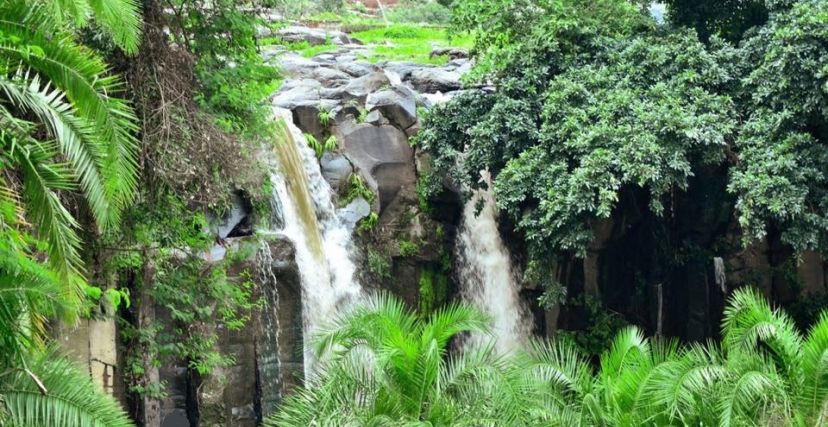
One of Jebel Marra's waterfalls. Source: Ultra Sudan
Ammuo's creations boast rich and varied themes, preserving the essence of religious chants like 'Lá̱ ylá.' They skillfully transmit the timeless spiritual feelings to today, blending ancient heritage with the present in pieces like 'Aromatic Air':
Is the breeze the blossom of the trees?
The breeze oozes like the Virgin Mary
Is the breeze the blossom of the trees?
In the quiet Khalwa, why douse the fires within?
O, ye wanderers!
"Paradise was crafted, its essence woven for you
In the quiet Khalwa, why douse the fires within?
And the song, 'Paradise Beneath the Dhikr gatherings':
The Fur are devoted people
Like believers in paradise
Paradise beneath the Dhikr gatherings
His gatherings are woven with silken threads
How does Fatima, daughter of the Prophet, spill tears?
Shall the Quran be lost
We shall not abandon it, even if it were but a single page
Ammou not only manifested respect for art in her works but also reflected it in her personal life. She married the third pillar of modern Fur music, the singer and musician Adam Bonga, who accompanied her in her artistic journey. He, too, followed her shortly after ten months of her passing on April 10, 2020. Bonga had a significant impact on Ammou's artistic career; together, they completed a collaborative project that included several songs such as "Skore" and "Let's Go to the Market and bring farming tools." This project differed noticeably from their individual works in terms of musical and melodic structure.
Bonga not only penned several enduring songs in Ammou's projects but also, in addition to being a skilled rebab player, assisted her in composing melodies, and also enabled her to overcome the challenges of travelling with a large musical band despite financial constraints. Bonga was her complete musical band, and he was her family.
Ammou was a professional singer, and she was well aware of it. Therefore, she carefully chose the means through which she communicated with her audience. In 1998, she participated in the Darfur States Festival in Nyala and won the gold medal. In 1999, she won the gold medal at the Festival of Nasheed (Islamic hymns). Then, in April 2002, she returned to claim the gold medal at the States Festival in Khartoum. In addition to her participation in the celebration of the independence of South Sudan in 2011, Ammou also took part in the first cultural heritage exhibition of Darfur in the United States in 2015. This indicates the extent to which she took on the task of modernizing Fur and Darfurian music.
The artistic impact of the elusive gazelle is evident through her extensive repertoire of 320 songs. She performed some of these songs for radio and television in Nyala and Omdurman. Additionally, she released several albums, with the first ones being "TéraTére," "Sho'ob Al-Diyar" (People of the Lands), and "Itha Zahabti Ilal Haqil" (If You Go to the Field). The rest of her songs were distributed across various festivals and performances.
(Do)
In various occasions and diverse representations in Ammou's works, women have a significant presence. This is evident whether in her use of the mother as a metaphor, as seen in "Rahm Wa Batin Al-Um" (A Mother's Womb and Belly) where she symbolizes homeland and land, or when she sings about the beauty of women, as in the song "Sahibat Al-Fustan Al-Jameel" (The Lady of the Beautiful Dress). Even in her encouragement for women to take a leading role in society, as portrayed in "Samhini" (Forgive Me)
Adorn the amulets around your waist
What is the man to make you tremble before him?
Draw a weapon and fire it at his neck
This coward is the one causing the loss of the youth
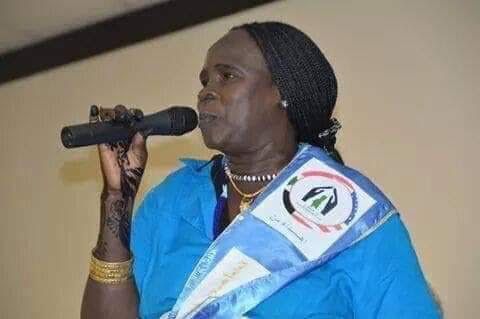
Maryam Amo. Source: Al-Bashayer newspaper
When Ammou left the country, she left all ten of her children behind. She would never meet them again and would not bear any more children. She would live the rest of her life carrying the bitterness of being away from her 'mercy of the world,' as she calls them in her captivating song 'Al-Atfal' (The Children). It is as if she was thinking of her children when she sang:
Let us encourage each other to go back to the homeland
Sudan is in our hearts, so don't worry, oh children
Or perhaps she was addressing herself when she sang with profound sorrow, as is her custom when yearning for her homeland or when singing for the children
People's greed for our land
Don't cry, my dear
Tomorrow we return to the homeland
There is no torment greater for a mother than being deprived of seeing her children for a lifetime. Ammou spent a lifetime in exile, waiting with a broken heart for the day when she would no longer fear the visit of her children, now scattered between Khartoum and Nyala. She hoped to return to her homeland, to enjoy the sights of the mountains, valleys, and fields of her birthplace.
Ammou grew up in a complex political environment in the modern history of Sudan, particularly in the context of Darfur. She was born just one year after Sudan gained independence and witnessed three coups, two civil wars, two famines, and three revolutionary movements that overthrew military, dictatorial, and totalitarian regimes. In Darfur specifically, her birth coincided with the establishment of the Red Flame Movement in 1957. She also experienced the activities of the Darfur Renaissance Front in 1964, which led to the leader Deraig reaching the parliament. Moreover, she witnessed a revolutionary movement in 1980 against the appointment of an outsider as the governor of Darfur. This movement successfully ousted Tayeb Murtada and appointed Deraig as the governor of the region. In 1991, there was a rebellion led by Dawood Yahya Bolad, and then she actively participated in the revolutionary movement that started at the end of 2002. In the Fur Society, she witnessed the conflict between the Fur and Arab communities in 1987. Additionally, the emergence of the revolutionary movement had profound effects on the regions and the Fur community. They, along with the rest of Darfur's people, experienced genocide, ethnic cleansing, displacement, and the refuge of hundreds of thousands due to these events.
With this life and artistic journey, Ammou encapsulates the history of post-independence Sudan and the history of the Darfur region and its people. Her life spans from the emergence of the Red Flame Movement just a year after independence and a year before Aboud's coup, continuing until her departure after the fall of Bashir's regime and the establishment of his security committee perpetrating the massacre at the Military General Command. This event coincided with other massacres across the country. She leaves behind a musical testament to the cultural, social, and political life that will last forever.
There was no other way to resolve Ammou's complex relationship with her homeland except to leave it by force and to return on a coffin. Like all the martyrs of revolutionary movements, like the martyrs of the Darfur war, and like the General Command massacre martyrs’, Ammou returned to her land with the courage she desired and now she can rest near her village Mirokabir, on the southern outskirts of Jabal Marra in Nyala. She can now spend her time gazing at the beauty and splendor of these valleys, mountains, and green fields as far as the eye can see until the time when the corn ripens.
